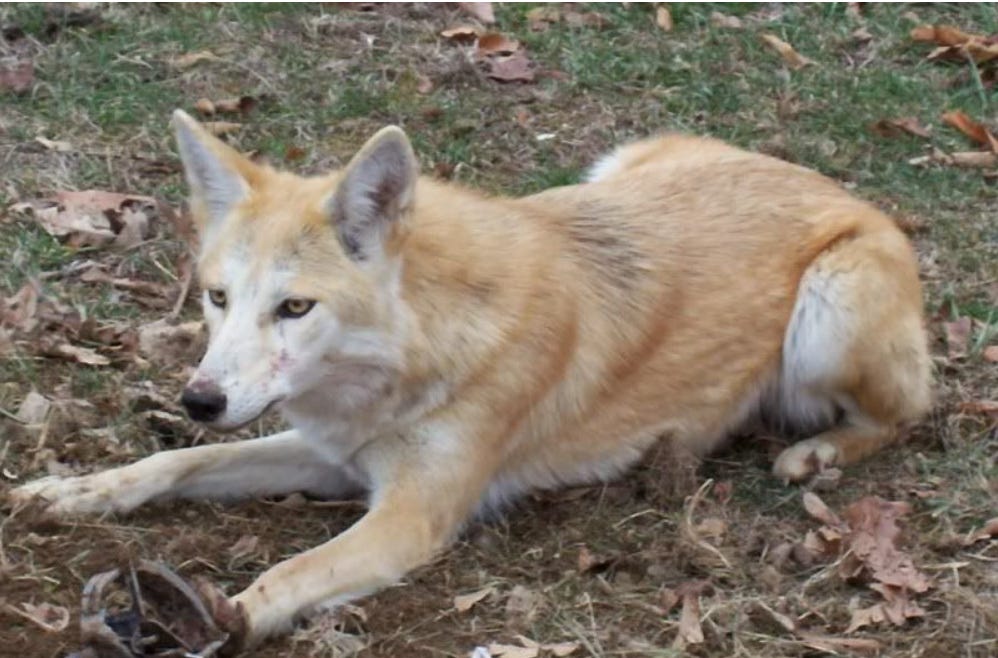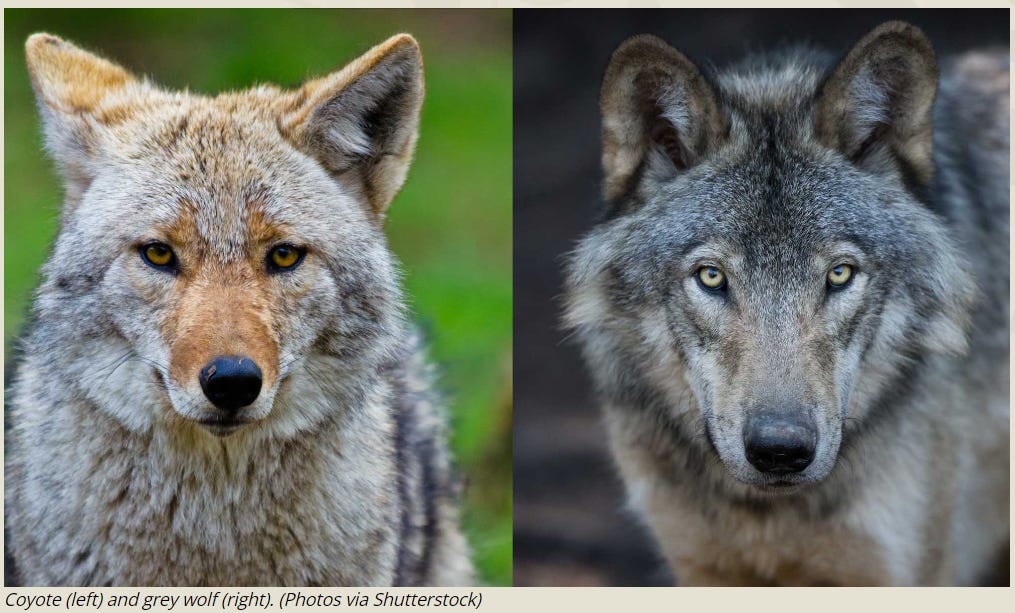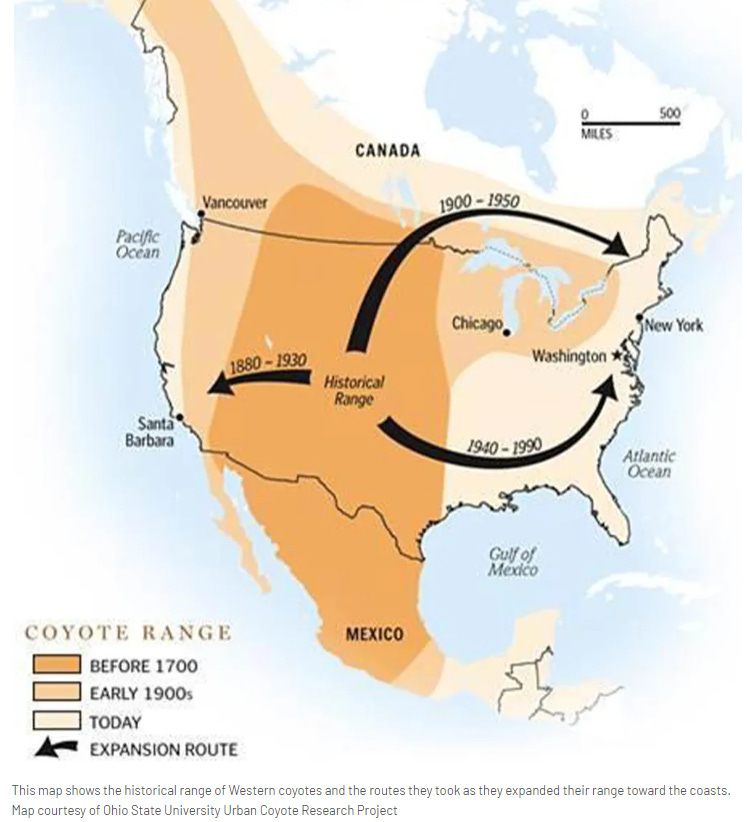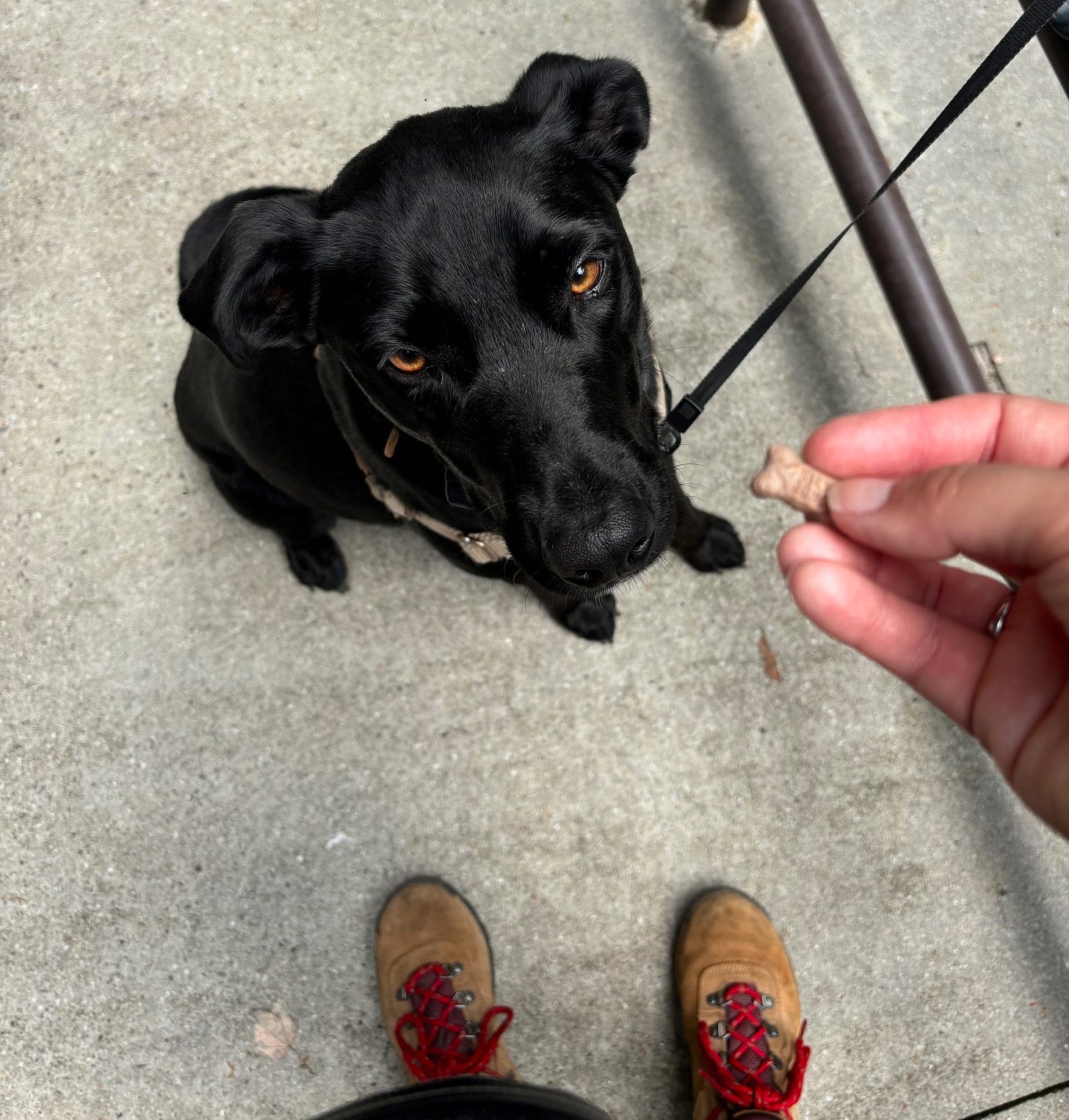Why don’t we hear about coyote-dog hybrids like we do wolf-dog hybrids?
Is one a better pet than the other?
This week’s question comes from Andrew. As we were hiking one day last week and came across a pile of coyote scat, he wondered aloud why there’s so much interest in wolf-dog hybrids but it’s rare to hear someone brag that their dog is a coyote hybrid.
Years ago, we had a friend whose wolf-hybrid was known to puncture the tires of the UPS truck when it made deliveries. When I worked at a camp during college, we had an organization bring wolf hybrids to an assembly so the kids could learn about them. But we counselors had to sit on the front row with all the campers behind us, and remain absolutely still if the wolfdog approached us.
Because of their potential unpredictability, wolfdogs are oftentimes regulated or even outlawed in some states. They are considered high-content hybrids if they are 75% or more wolf. The enormous wolfdog in the photo above is 87% wolf, and as my dad would say, 13% trustworthy.
I learned there are between 250,000 and 500,000 wolfdogs in the U.S., and they’ve grown in popularity due to social media and shows like Game of Thrones that have wolf-like characters. But what about coyotes?
Are there coyote-dog hybrids?
Coyotes, like skunks, only live in the Americas and are much smaller than wolves, who live within the Northern hemisphere in North America, Europe, and Russia. Coyotes tend to be about 4 feet long and weigh around 35 pounds, whereas wolves can stretch to 6 feet and top out at 100 pounds. Coyotes have more pointy muzzles and large pointed ears:
Both animals can live in a wide variety of habitats – forests, deserts, and prairies – but only coyotes choose to also live alongside humans in urban areas. There are many stories of people seeing coyotes in subdivisions and occasionally losing a beloved pet to these lone hunters.
While wolves are carnivores and work in packs to take down deer and elk, coyotes are omnivores and though they prefer meat they will eat apples, berries, grass, insects, frogs, small mammals, birds, snakes, and even carrion. This versatility in diet is part of what has allowed them to be so widespread across the continent. Only 13 states in the U.S. have wolves in protected areas numbering around 14,000-18,000 total. In contrast, there are estimated to be 90,000 coyotes in my state – Georgia – alone. The total U.S. population may be 2.9 to 4 million. That’s a huge number of coyotes!
With those numbers, you’d think there would be a high incidence of interbreeding between coyotes and dogs, especially with coyotes being fairly urbanized. Surprisingly, this is not the case.
A cross between a coyote and a dog is called a coydog. These mixes are much less popular than the wolfdog hybrids because they are A) hard to produce and B) tend to be more aggressive and less trustworthy in captivity than wolfdogs.
Let’s address B first. Wolves are pack animals with a developed social structure complete with leaders and social rules. Today’s dogs evolved from wolves and adapted to life with humans fairly easily due to this ease with living in a pack. Wolfdogs, especially those with more dog than wolf, seem to adapt to living with humans fairly well (despite the occasional attack of a UPS truck – in their defense, domestic dogs hate those trucks too…).
On the other hand, coyotes tend to be loners. They don’t live in packs and at most hunt in pairs, oftentimes “parallel hunting” by going after separate animals nearby each other rather than coordinating their attacks. Because of this lack of social structure, folks who have bred and adopted coydogs report that they tend to be more skittish and aggressive around strangers and small children. One blogger’s coydog peed on everything and couldn’t seem to settle in to the living arrangement well.

In all fairness, the same could be said of a wolfdog, especially one with high content of wolf genes. The more wolf there is, the wilder the animal.
But there’s another reason coydogs are less common, and it has to do with the difficulty of breeding them. Almost all existing coydogs are bred in captivity. There are very few incidents of wild coyotes breeding with domesticated dogs for a variety of reasons: coyotes have a very short breeding window (January to March) which may not overlap with dogs, around 80% of American dogs are neutered and incapable of reproducing, and most interesting of all (to me) is that coyotes mate for life and would therefore be unlikely to pair up with a random dog. Unlike dogs, male coyotes participate in the rearing of their young. If a female coyote mated with a dog, she would likely struggle to raise them to adulthood on her own.
All of this means that if you see pictures on the internet of a wild dog someone claims is a cross with a coyote, it’s unlikely to be true. Wild coydogs are not a huge issue.
HOWEVER! It seems that coyotes in the eastern half of the U.S. already contain a mixture of bloodlines. Researchers have done genetic testing on eastern coyotes and found a typical eastern coyote in the U.S. “has roughly 60 percent genetic influence from coyote, 30 percent wolf, and 10 percent dog.” This is due to interbreeding about 100 years ago and explains why eastern coyotes tend to be about 10 pounds heavier than their western cousins.
Why did the interbreeding occur? As Europeans settled in the Americas and began to kill off the wolves, coyotes took that opportunity to expand and fill in the void. Pioneering coyotes on the leading edge of their encroachment bred with wolves and the occasional domesticated dog near human settlements.
Coyotes only bred with wolves (and the occasional dog) out of necessity – the leading lone animals pushing into new territory mated outside their species only when other coyotes were not available. Now that coyotes are well-established across much of the country, they can find other coyotes as mates and interbreeding is rare between coyotes and dogs.
Incidentally, since dogs evolved from wolves, they are the same species (dogs are Canis lupus familiaris) and therefore wolfdogs are not technically “hybrids”. Coyotes, however, are a different species (Canis latrans) and so coydogs are true hybrids. But as a result of this, coydogs have lower fertility rates, another aspect that makes breeding them difficult.

All of this has me grateful for my own domesticated dog with his bred-in affection and puppy aspects that make him appealing to humans and able to comfortably live with his human pack. What about you? Have you encountered any wolfdogs or coydogs?









While I do understand that there are people who like "exotic" animals, and I have personally worked with some very exotic animals, but my question is, 'why would you want to"? We had, in our structured zoo habitat, a wolf-dog. For nearly a year he was great and then while leash walking with his handler one day turned on him (literally no provocation) and tore him up seriously. Wild animals are just that and were never intended for domestic pets, part bred or not. There are so many beautiful wonderful dogs, many begging for a home I cannot see trying to domesticate a part wild breed.
years ago i lived out in the wild chaparral of south texas / i could hear the coyotes out there but never saw them / one day i say a 'coyote' by road alone / i thought that was weird / then i saw a 'coyote' following the neighbor's dog home and the neighbor's dog had his tail tucked underneath / obviously uncomfortable / then i saw the 'coyote' sniffing around the hot tub on my porch / i finally realized that it wasn't a coyote and it wasn't a dog - it was a coydog / he looked exactly like a coyote and had a fragrant aroma like i'm told coyotes do / i adopted him and brought him with me when we moved into town / we were soulmates / we had an amazing connection / whenever we were with a group of people he would visit each one and make sure they were ok or he would give them a bump up / i could tell you lots of stories about kio but in short he was the coolest smartest gentlest dog i have ever known